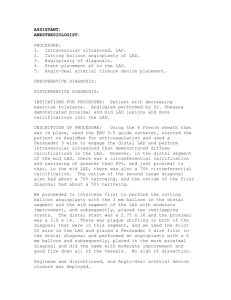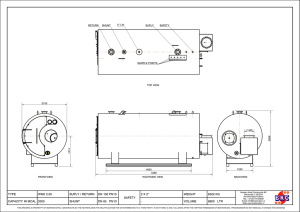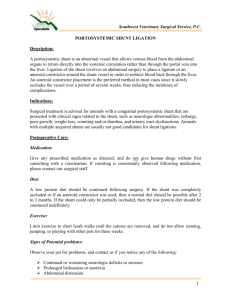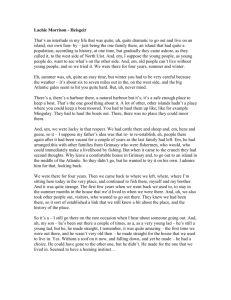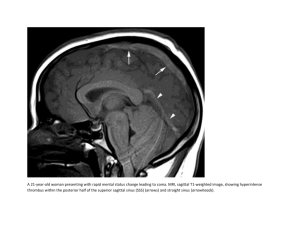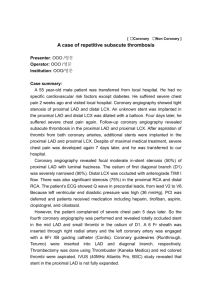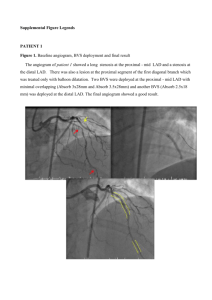Off Pump CABG Essay (Word Doc)
advertisement
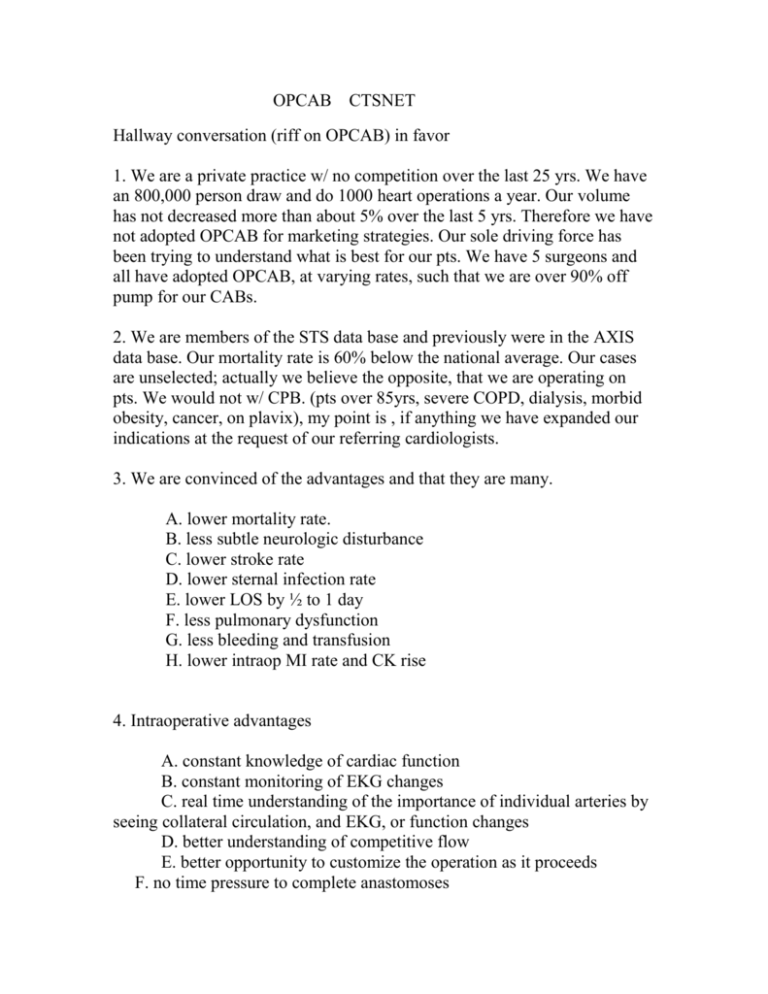
OPCAB CTSNET Hallway conversation (riff on OPCAB) in favor 1. We are a private practice w/ no competition over the last 25 yrs. We have an 800,000 person draw and do 1000 heart operations a year. Our volume has not decreased more than about 5% over the last 5 yrs. Therefore we have not adopted OPCAB for marketing strategies. Our sole driving force has been trying to understand what is best for our pts. We have 5 surgeons and all have adopted OPCAB, at varying rates, such that we are over 90% off pump for our CABs. 2. We are members of the STS data base and previously were in the AXIS data base. Our mortality rate is 60% below the national average. Our cases are unselected; actually we believe the opposite, that we are operating on pts. We would not w/ CPB. (pts over 85yrs, severe COPD, dialysis, morbid obesity, cancer, on plavix), my point is , if anything we have expanded our indications at the request of our referring cardiologists. 3. We are convinced of the advantages and that they are many. A. lower mortality rate. B. less subtle neurologic disturbance C. lower stroke rate D. lower sternal infection rate E. lower LOS by ½ to 1 day F. less pulmonary dysfunction G. less bleeding and transfusion H. lower intraop MI rate and CK rise 4. Intraoperative advantages A. constant knowledge of cardiac function B. constant monitoring of EKG changes C. real time understanding of the importance of individual arteries by seeing collateral circulation, and EKG, or function changes D. better understanding of competitive flow E. better opportunity to customize the operation as it proceeds F. no time pressure to complete anastomoses G. no possibility of accepting an anastomosis that changes the EKG adversely H. ability to see the heart improve real time as grafts are opened I. better ability to handle calcified aorta J. less use of inotropic agents since there is no “coming off” K. when you finish proximals YOU”RE DONE!! Points we feel are not changed by OPCAB 1. No change in Afib rate SIMPLIFIED OPCAB 1. Learning: We do feel there is a learning curve as we have all gone through it at varying rates. We agree with the initial cases being single LIMA to the LAD. Then LAD plus RCA/RPD/RIV. Then LAD plus RCA plus Ramus. And finally the addition of the OM branches. There are plenty of cases not requiring OM grafts that are available on which to refine one’s skills. Secondly, the use of a shunt in all anastomoses is helpful in learning. Thirdly, a great deal of patience is required, and we are not sure every surgeon’s personality is well suited to OPCAB, however, our five personalities are needless to say quite different. Patience is required primarily to set up each anastomosis in three dimensions, and to assure stable and adequate physiology in conjunction with anesthesia. It must be said though that the operative time is shorter once the techniques are learned. HERE ARE THE STEPS OUTLINED 1. Median sternotomy incision 2. EVH we use the Guidant system vasoview 7 a) give 5,000 units heparin prior to vein harvest 3. IMA(s) and or radial artery harvest 4. Open pericardium to allow the RV to come over to the right -incise down to SVC -incise angle lateral to IVC and push -it is not necessary to open the right pleura -tack up the pericardium to 2nd rib on left to make a path for LIMA 5. Open the fascia over the IMA -check size, spasm, branches, flow 6. Give 15,000 units of heparin. We prefer an ACT over 300 seconds and then recheck in one hour. -you can do a case without heparin if you lyse the vein valves to enable flushing and use a shunt, In H.I.T. for instance 7. Place one 2-0 ethibond in the pericardial well near the junction of the left inferior pulmonary vein, by lifting the heart up and to the right with your left hand. Place a thin lap (3"x18") between the suture and secure with a red rubber tourniquet. Pulling up a little moves the LAD in view. Pulling up further exposes the diagonal and then the ramus. To graft the right before the bifurcation we hold the heart only with the stabilizer. . For the RPD and RIV we lift the apex straight up and keep the heart from slipping to the left with the lap. For the OM branches we pull the apex up and to the lower right with the lap and open the sternum further if needed. The stabilizer is positioned as follows. Almost always on the right side, for LAD - inferior, for RCA superior, for OM - middle. 8. We use the stabilizer from Chase Medical (Dallas) on which the arm is extremely stable and does not rock at all. We do not use suction on the stabilizer or an apical suction device. Our sternal retractor is also made by Chase. 5. Evaluate the ascending aorta by palpation -include info from CT, TEE, epicardial US, cines as available 6. Evaluate IMA size, radial, vein suitability and make a plan for distal and proximal anastomoses and compare to pre-op plan. -worrisome aorta plan demands “no touch” and proximal anastomoses to IMAs or innominate artery -we have abandoned proximal devices at present with the very occasional exception of the Enclose device (Novare medical) -proximals to IMA may be constructed first -evaluate LIMA for sequencing to the diagonal-LAD -we almost always do the LIMA to LAD first as it provides physiologic stability and may take an EF of 25% and change it to 40% as you watch - occasionally we may do proximal vein anastomoses first and establish flow, especially to a large right system, allowing the LIMA and RCA system grafts to be open before positioning for the Oms. This not uncommonly will give the pt. 4 grafts open before OM positioning. 7. Distal considerations: -7-0-8-0 suture -pick a place to open the artery where you can place a shunt -retract-o-tape proximally thru epicardial rents created with a beaver blade, preferably in a non calcified spot -you may place a shunt but not let it flow too keep a dry field if no physiologic need for the shunt, and sew around it -it is helpful to pull on the shunt to expose the lateral artery walls -slide the shunt back and forth to assure you haven't sewn it in if there is a question -if a stitch catches the shunt cord, the cord can be cut off with an eye blade -if a stitch goes through the plastic it will pull through the plastic and not break the suture -make sure the native artery is flowing where the retrac-o-tape was placed before tying the anastomotic suture. -tie the suture under pressure so you can see the anastomosis in its completed state and know how much to pull to avoid purse-stringing and to achieve hemostasis along the suture line -if a shunt is flowing you may replace the heart in the anatomic positon to let the heart recover or let anesthesia catch up, the bleeding will not be excessive (very seldom necessary) -if the retract-o-tape causes venous bleeding it can usually be ignored and may be resolved by the time the anatomosis is finished. If not, sew up the retract-o-tape epicardial holes with a 6-0 -an intramyocardial LAD or Ramus can be dissected out -Bovie epicardial venous bleeders with the Bovie on 12 -if it seems unsafe to place a tape under a very deep LAD it may be temporarily occluded with a small bulldog (seraphim) or even pick-ups and opened and a shunt inserted without permanent proximal control -with tremendous retrograde flow a shunt will dry up the field although not needed physiologically. A tape distally occasionally is used. -sequential grafts may be measured exactly to length -a small flat bulldog (Weck clip) is helpful between sequential anstomoses 8. Proximal anastomosis considerations if aorta is OK -cut grafts to exact length, no need for extra -do not inject vein solution into the coronaries -clean fat off aorta so clamp doesn’t slip -lower BP to 85-90 and keep there to avoid intimal injury -apply clamp only to the click where no more blood can be pressed back into the aorta -put a wet lap around the handle to limit movement and torque -make one hole at a time, we use 4.8 punch or 4.0 for radial or small vein -sew proximals with a 6-0 -evacuate air to limit transient EKG changes 9. Place a graft marker (pulled from a Ray-tex) and Blake drain(s) 24F 10. Give protamine 1:1 10. Pacing wires as desired 11. Close -8 wires minimum -always 3 in manubrium -consider double wires -wires go around sternum -in fragile old people put some wires through the ribs lateral to the cartilages -no bone wax TOOLS Chase Retractor Chase Medical, Dallas Chase Stabilizer “ “ Retract-O-Tape ref 1041 CE Ultra Point Eye Blade 4mm 22.5 degrees SynoVis Flo-thru shunt ref. FT-12150 sizes 1.5, 2.0, 2.5, 3.0 Weck flat bulldogs (also called brachial clips) 3"x18" lap for retraction Mister - Blower Medtronic Chase retractor Chase stabilizer Stabilizer brush LIMA harvest w intact pleura LAD exposed LAD stabilized LAD shunted LIMA completed RCA exposed RCA distal RPD exposure OM exposure OM 1 distal Circumflex exposure Proximal set up (note stabilization of clamp handle) Graft marker placed


